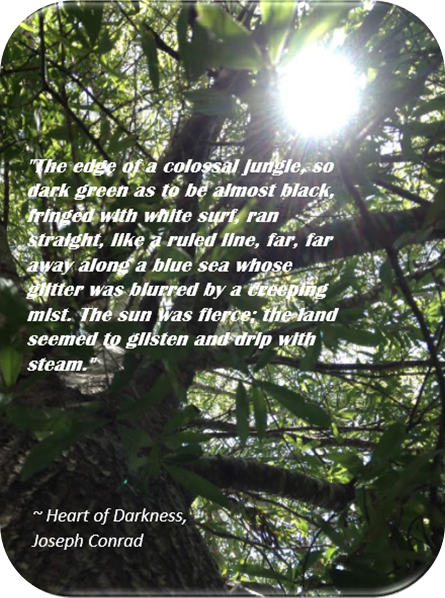by Kayla I. Shown-Dean
At a writing conference, I was shocked and appalled to hear one of our speakers announce, “Pretty prose is dead.”
While I realize this person has much more experience than me in professional reading/writing, I’m afraid I’d have to disagree. Pretty prose has several distinct purposes. First and foremost, it exists to paint a picture for the reader. The following passage is an example of pretty prose taken from Joseph Conrad’s Heart of Darkness. It paints a beautiful picture, setting in this scene for the reader.

I mean, could you imagine if Conrad had simply written: “There was a large jungle whose trees formed a straight line in a faraway land by the ocean. It was foggy there, probably because it was so hot.”
What kind of picture does that form in your mind’s eye?
I honestly believe that to remove pretty prose is to take the art out of writing. It takes years of hard work and practice (countless hours spent) to perfect each passage at the sentence level. It often means writing, rewriting, editing, rewriting, rewriting, editing, and rewriting three or four more times. It means being selective about your word choice. Each word has been chosen for purpose and clarity—and if you’re one of those writers who loves to employ symbolism, theme, and motif, this task is doubly difficult. Still, it is well worth the work.
For example, there’s a passage in Emily Bronte’s Wuthering Heights that is absolutely breath-taking.

While on a surface-level reading, it appears as only a description of the distraught Heathcliff, but because of the author’s use of the word cloud, the reader can see that there is some deep storm brewing within this man. In fact, word cloud is used 24 times in this story, making it a reoccurring symbol as it reveals the ever-changing mood of its characters.
So now, you may be wondering: how can I write pretty prose?
To answer simply: it takes a lot of practice. However, there are lots of tools you can employ to help you along the way.
1.) Describe, describe, describe
As you’ve learned, pretty prose is a lot of description. So pull out those adjectives! If you’re looking outside, what colors do you see? Are there any shadows? Where is the sun? (That can be used as a subtle way to indicate the time.) What textures and shapes are out there? Do you have any snow on the ground? Is it melting, fresh, mushy? Etc.
2.) Use your five senses.
Don’t just limit yourself to your sense of sight. Yes, we depend on this sense the most, but your other senses have a lot to contribute to the painting of your setting. What sounds do you hear? How does it feel? Is it windy? Is it hot? Dry? Cold? What does it smell like? Is there a crisp, cool wind? Does it smell of pine? And for all you foodies out there: taste. I believe this is one of the least used senses when it comes to writing. When our characters are eating, we tend to just say what they eat, but we don’t describe its taste. Bring your readers in with you; make them hungry!
3.) Pull out those similes and metaphors.
What does that pie taste like? Is it similar to another kind of dessert? What about the noises you hear? Do your kids run around the house screaming like a cat getting run over by a garbage truck? Or is your husband a sloth of a man? Using similes and metaphors can help make personal situations more relatable to your readers.
** Remember, a simile is a comparison of two things using like or as, while a metaphor compares two things without the use of the prepositions.**
4.) Be consistent with any set theme or motif.
For example, if you’re working with reoccurring symbols of darkness and light and you’ve decided to let darkness represent ignorance and light represent knowledge, make sure that you haven’t shifted gears or gotten your wires crossed somewhere in your writing process. An easy way to do this is to do a find-word search in Microsoft Word. Then you can search each time you used the word light to make sure it is used in the way in which you intended.
Assignment time: (you knew it was coming, right?)
To practice pretty prose, I want you all to write a paragraph describing what you see (touch, taste, hear, smell) when you’re in your own backyards. Go ahead; reveal in the magic of pretty prose. Then, paste your paragraphs in the comment section or post them to social media using the hashtag #magicalstory.
